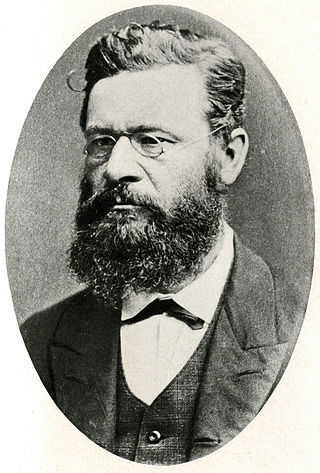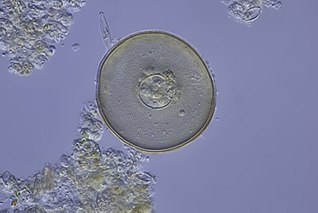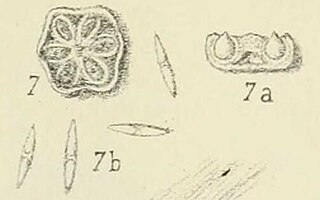Related Research Articles

Mycology is the branch of biology concerned with the study of fungi, including their taxonomy, genetics, biochemical properties, and use by humans. Fungi can be a source of tinder, food, traditional medicine, as well as entheogens, poison, and infection.
Genus is a taxonomic rank used in the biological classification of living and fossil organisms as well as viruses. In the hierarchy of biological classification, genus comes above species and below family. In binomial nomenclature, the genus name forms the first part of the binomial species name for each species within the genus.

Eurotiomycetes is a large class of ascomycetes with cleistothecial ascocarps within the subphylum Pezizomycotina, currently containing around 3810 species according to the Catalogue of Life. It is the third largest lichenized class, with more than 1200 lichen species that are mostly bitunicate in the formation of asci. It contains most of the fungi previously known morphologically as "Plectomycetes".

Petter Adolf Karsten was a Finnish mycologist, the foremost expert on the fungi of Finland in his day, and known in consequence as the "father of Finnish mycology".
Hyphochytrids are eukaryotic organisms in the group of Stramenopiles (Heterokonta).

Blastocladiomycota is one of the currently recognized phyla within the kingdom Fungi. Blastocladiomycota was originally the order Blastocladiales within the phylum Chytridiomycota until molecular and zoospore ultrastructural characters were used to demonstrate it was not monophyletic with Chytridiomycota. The order was first erected by Petersen for a single genus, Blastocladia, which was originally considered a member of the oomycetes. Accordingly, members of Blastocladiomycota are often referred to colloquially as "chytrids." However, some feel "chytrid" should refer only to members of Chytridiomycota. Thus, members of Blastocladiomyota are commonly called "blastoclads" by mycologists. Alternatively, members of Blastocladiomycota, Chytridiomycota, and Neocallimastigomycota lumped together as the zoosporic true fungi. Blastocladiomycota contains 5 families and approximately 12 genera. This early diverging branch of kingdom Fungi is the first to exhibit alternation of generations. As well, two (once) popular model organisms—Allomyces macrogynus and Blastocladiella emersonii—belong to this phylum.

Arcella is a genus of testate amoebae in the order Arcellinida, usually found in freshwaters and mosses, and rarely in soils. A key characteristic of Arcella is the circular test with a hole on its center from where finger-like pseudopods emerge. It is one of the largest testacean genera.

The corticioid fungi are a group of fungi in the Basidiomycota typically having effused, smooth basidiocarps that are formed on the undersides of dead tree trunks or branches. They are sometimes colloquially called crust fungi or patch fungi. Originally such fungi were referred to the genus Corticium and subsequently to the family Corticiaceae, but it is now known that all corticioid species are not necessarily closely related. The fact that they look similar is an example of convergent evolution. Since they are often studied as a group, it is convenient to retain the informal (non-taxonomic) name of "corticioid fungi" and this term is frequently used in research papers and other texts.

The clavarioid fungi are a group of fungi in the Basidiomycota typically having erect, simple or branched basidiocarps that are formed on the ground, on decaying vegetation, or on dead wood. They are colloquially called club fungi and coral fungi.

The hydnoid fungi are a group of fungi in the Basidiomycota with basidiocarps producing spores on pendant, tooth-like or spine-like projections. They are colloquially called tooth fungi. Originally such fungi were referred to the genus Hydnum, but it is now known that not all hydnoid species are closely related.

Exidiopsis is a genus of fungi in the family Auriculariaceae. The genus has a widespread distribution and contains around 30 species. One species, Exidiopsis effusa, is responsible for the formation of hair ice on dead wood.

Aschersonia is a genus of fungi in the order Hypocreales and family Clavicipitaceae.
Chinochthamalus is a genus of star barnacles in the family Chthamalidae. There is one described species in Chinochthamalus, C. scutelliformis.
References
- ↑ Kirk PM, Cannon PF, Minter DW, Stalpers JA (2008). Dictionary of the Fungi (10th ed.). Wallingford, UK: CABI. p. 626. ISBN 978-0-85199-826-8.